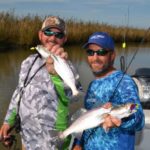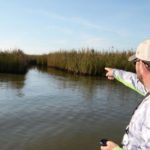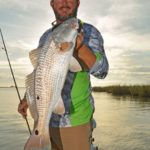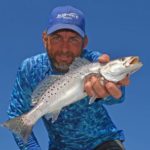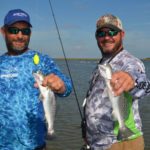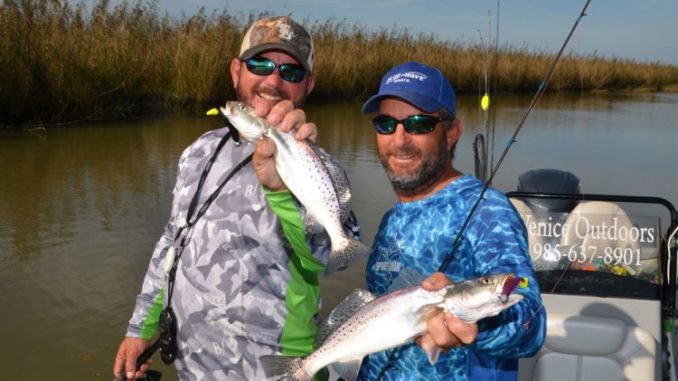
Sure, live bait will always catch more fish. But the Ballay brothers insist artificial lures are all you really need for speckled trout and redfish down in Venice.
Venice is arguably the ultimate fishing destination.
Grand Isle fans would probably dispute that, but Grand Isle has more: It has beaches, shopping (at least a little), a goodly number of restaurants and even a big grocery store.
But Venice is just fishing — raw power-fishing.
I was there to fish with the strongest name in Venice fishing history: Ballay. Two Ballays, actually — brothers Brandon and Brent.
“We want to talk to you about fishing the old way in Venice, all artificials; no live bait,” said Brandon. “Venice was made the fishing destination that it is today with artificials.”
“Ten years ago there was no live bait for sale in Venice,” Brent said. “Live bait is good, but it’s expensive and it’s a slow way to fish.”
Brother Brandon expanded.
“To fish your way down a bank to find fish, you might waste 20 shrimp.
“We are more run-and-gun; hit a spot and move. People have gotten lazy. They don’t want to fish without live bait.”
“Let me give you an example,” croaked Brandon. “Yesterday a guy came into the marina and asked for 150 live shrimp. An employee told him they were out. The fisherman huffed, ‘Now how in the hell am I gonna catch fish?’
“It’s easier.”
“You don’t have to cast as much,” agreed Brent. “Plus, you don’t have to learn the art of deceiving fish.”
“It’s not just about numbers,” Brandon shook his head. “You shouldn’t just judge your trip on numbers alone.
“When I take a guy out, I want to teach him how to fish. You can’t teach a guy how to fish with live bait.”
“Yeah,” agreed his brother. “If they fish with us and learn how to fish and come to the marina and they are out of bait, they can still fish,” he said, shaking his rod in a clenched fist for emphasis.
“We go the extra mile teaching people where to fish, how to present their lures, how to feel bites and how to set the hook,” added Brandon. “We are not opposed to using bait. Some customers request live bait.
“We both buy 2 or 3 pounds of dead shrimp every day for insurance. Tipping jig hooks with a piece of shrimp adds smell — good for reds, flounder, sheepshead and drum.”
“Everything but trout,” finished Brent.
Finding fish is important of course. If the fish aren’t found, no bait works.
“Everyone has access to satellite photographic maps such Google Earth, Standard Maps or chips in their GPS,” Brandon said.
“We still use them to find cuts and ponds. For instance, coming down here this morning, Brent was on Google Earth scouting for spots and making a game plan.”
Going red
The brothers decided to begin their quest to show how effective artificial lures are in Venice by targeting redfish first and speckled trout second. It was kind of an unusual move, since speck fishing is often considered best in low-light conditions and redfish are more dependable, being semi-anchored to a spot of home turf in the marsh.
But tides are important to the way they fish, so it was redfish first.
They left the marina and headed west out through Tiger Pass, ran across Dixon Bay and fished the first and second spillways off of Southwest Pass from the north. (Spillways is a local term for what hydrologists call distributaries, smaller channels that shunt water from a larger pass to Gulf waters. )
These are not hard to find, as they are labeled “First Spillway” and Second Spillway” on maps.
They stopped at a likely looking drain, essentially a watery cut into the marsh grass. “On a falling tide, like we have this morning, the water flushes out of ponds in the marsh into the spillway,” Brandon said.
“The water brings shrimp, mullet, crabs and pogies with it. The fish will set outside the drain on a drop-off. You never know what’s going to be there. It could be trout in one, redfish in another and flounder in still another.”
He situated his boat outside the drain in 10 or 12 feet of water. They cast 3 or 4 feet into the drain and bounced their lures out on a tight-line.
The action was immediate, with both hooking up on good reds.
“Any time the (Mississippi) river gets low, under 4 feet on the New Orleans gauge, the fish will go into the river system and they will relate to these drains.
“Even on a rising tide, they will be within 100 yards of the drain. A rising tide slows the river current down and makes it easier to fish. We can use singles instead of doubles.”
The doubles Brandon was talking about were tandem rigs, hand-tied with 30-pound test mono, with 3/8-ounce jigheads and H & H Cocahoe Minnow soft plastics. Later in the day they shifted to single rigs, especially when they clipped on oval corks for trout, but the color of the plastic tails was constant.
The go-to colors in Venice, they said, are black-and-chartreuse or purple-and-chartreuse, 365 days a year. “Find another color on my boat,” challenged Brandon.
A couple more drains and their limit of slot redfish was in the boat, in addition to a couple of bulls they set free.
Time for trout
They didn’t go far in their hunt for quicksilver action, moving into a canal system in the marsh between the first and second spillways.
“For some reason,” tutored Brandon, “in Venice, trout, and for that matter reds too, like to be where a canal makes a Y. The fish are located near the junction of the Y. Redfish will be along the bank and trout will hold in the middle of the canal.”
They bounced their baits off the bottom — pause one, two, three, then hop and let it drop to the bottom. Pause again and repeat. The specks always hit the jigs on the drop.
Brandon’s most effective technique was to cast cross-current and let the current sweep the lure down-current, then hop the jigs all the way back up-current to the boat.
The action was good, but they needed to make 50 fish, so they moved a short ways down the canal to a tiny drain dribbling different-colored water into the canal. It wasn’t much to look at, but it was enough to hold trout.
Still fishing on the bottom, they added more trout to the box. But following their run-and-gun philosophy, they pulled off biting fish to look for more. They found them where the canal emptied into Dixon Bay.
After anchoring, they swapped to single jigs under corks to fish the more open waters. Both often use corks in the summer and early fall when trout are in 2 to 4 feet of water.
Here they really conked the fish, ending what can only be called a perfect Venice day.
Credentials
To speak with the authority that Brandon and Brent Ballay do, you had to have had your passport stamped. You can’t talk scuttlebutt.
The brothers are relatively young; Brandon is 44 and Brent is 42, but they have owned their own guiding businesses for 26 and 23 years, respectively. But the name Ballay pushes a big wake in Venice — because of their pedigree, as well as their own skills and experiences.
Their father Dave ran a part-time offshore charter boat well over 40 years ago. At that time only one marina existed in Venice, Ellzey’s. It was a ramp and a hoist, nothing more — no ice, no tackle, no fuel, no snacks and no drinks.
“In the 1980s, Dad saw the need for a full service marina in Venice,” Brandon said. “His best friend Mike Bush was a bank president and loaned him the money to start.
“He got a long-term contract to lease a patch of bare mud 4 miles south of the end of road and immediately began construction. Venice Marina opened in the fall of 1985. I was 11 years old.”
“Bass fishermen ate it up,” added Brent. “They finally had a place to park.”
The brothers had grown up so far in Jesuit Bend, but their parents bought a house in Buras and they had a camper at the marina as well as a houseboat. They boys loved it.
“All we did was hunt and fish every day,” laughed Brandon. “We fished off the dock, duck hunted behind the marina and rabbit hunted on the banks of the Mississippi River. We probably didn’t appreciate it until we were about 30.”
Dave and wife Debbie sold the marina in 2002. “Dad was burnt out — seven days a week, 365 days a year. He didn’t even close for Christmas,” Brandon said.
They retired “full-time” to their home in Lumberton, Mississippi and moved to Hurtsboro, Alabama in 2013.
Brandon started deck-handing on a boat when he was 13. “That, and a complete lack of interest in school, led me to begin chartering at 18 years old. When I began chartering, there were two offshore guides and one inshore guide in Venice. I was number three offshore.”
Now he ballparks that there are probably 100 to 150 full-time guides and 75 part-timers working out of the tiny port.
As for Brent, he started early, deck-handing for guide Mike Frenette when he was 11. “I deck-handed for him and Brandon on weekends and holidays. Then I went to Southeastern Louisiana University.
“The whole time there I was wishing I was hunting and fishing. I took that fancy calculator with all the fancy buttons on it and figured out how much money I was losing.
“So I came home and started fishing.”
Both run their charter businesses, Venice Outdoors (985-637-8901) for Brandon and Cast n Blast Venice (985-960-2605) for Brent, out of Venice Marina, now owned by Mike and Bill Butler.
